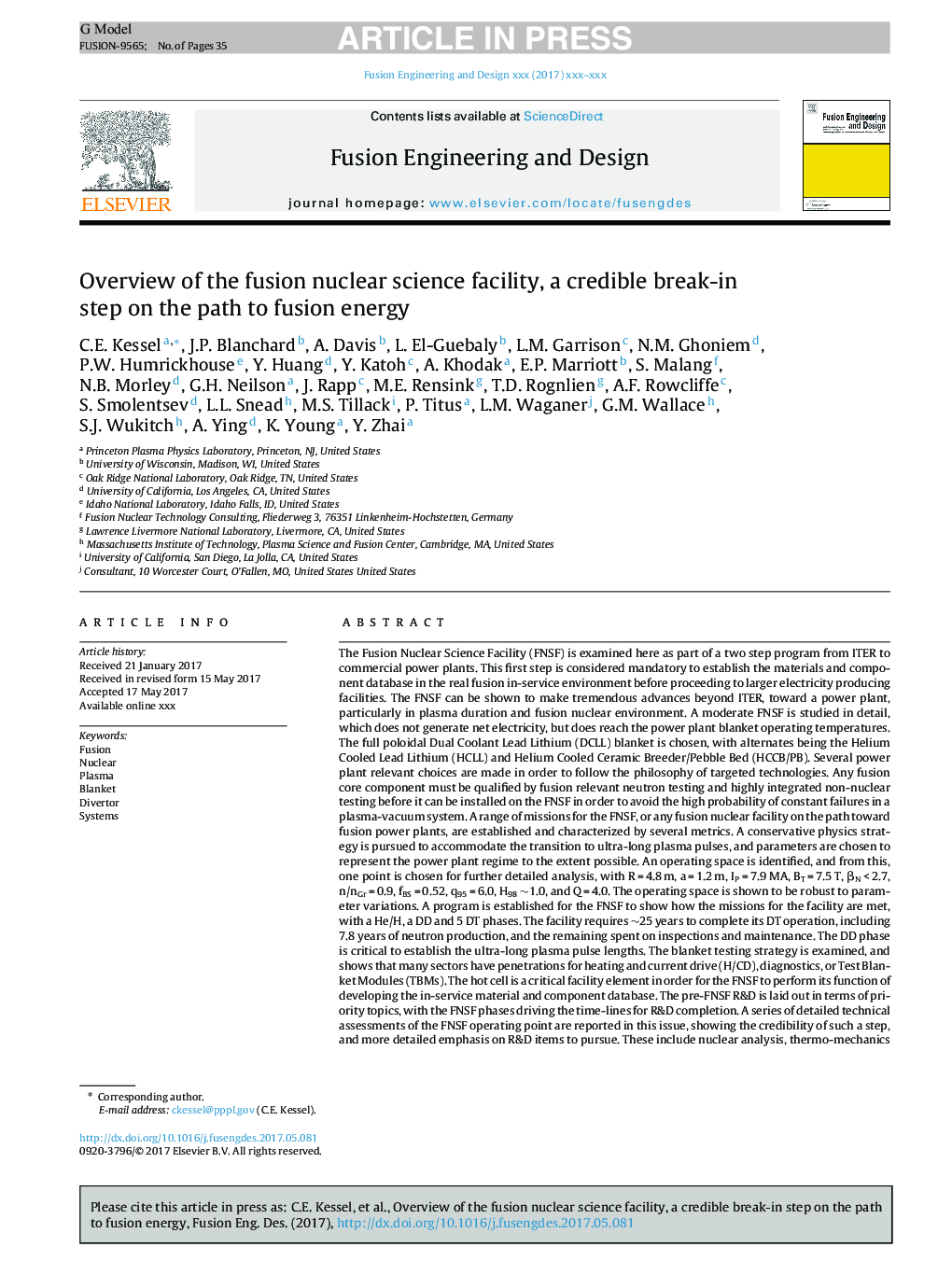| کد مقاله | کد نشریه | سال انتشار | مقاله انگلیسی | نسخه تمام متن |
|---|---|---|---|---|
| 10225351 | 1701170 | 2018 | 35 صفحه PDF | دانلود رایگان |
عنوان انگلیسی مقاله ISI
Overview of the fusion nuclear science facility, a credible break-in step on the path to fusion energy
ترجمه فارسی عنوان
بررسی اجمالی از تأسیسات هسته یی هسته ی همجوشی، یک گام معتبر در مسیر یابی به انرژی همجوشی است
دانلود مقاله + سفارش ترجمه
دانلود مقاله ISI انگلیسی
رایگان برای ایرانیان
کلمات کلیدی
موضوعات مرتبط
مهندسی و علوم پایه
مهندسی انرژی
مهندسی انرژی و فناوری های برق
چکیده انگلیسی
The Fusion Nuclear Science Facility (FNSF) is examined here as part of a two step program from ITER to commercial power plants. This first step is considered mandatory to establish the materials and component database in the real fusion in-service environment before proceeding to larger electricity producing facilities. The FNSF can be shown to make tremendous advances beyond ITER, toward a power plant, particularly in plasma duration and fusion nuclear environment. A moderate FNSF is studied in detail, which does not generate net electricity, but does reach the power plant blanket operating temperatures. The full poloidal Dual Coolant Lead Lithium (DCLL) blanket is chosen, with alternates being the Helium Cooled Lead Lithium (HCLL) and Helium Cooled Ceramic Breeder/Pebble Bed (HCCB/PB). Several power plant relevant choices are made in order to follow the philosophy of targeted technologies. Any fusion core component must be qualified by fusion relevant neutron testing and highly integrated non-nuclear testing before it can be installed on the FNSF in order to avoid the high probability of constant failures in a plasma-vacuum system. A range of missions for the FNSF, or any fusion nuclear facility on the path toward fusion power plants, are established and characterized by several metrics. A conservative physics strategy is pursued to accommodate the transition to ultra-long plasma pulses, and parameters are chosen to represent the power plant regime to the extent possible. An operating space is identified, and from this, one point is chosen for further detailed analysis, with R = 4.8 m, a = 1.2 m, IP = 7.9 MA, BT = 7.5 T, βN < 2.7, n/nGr = 0.9, fBS = 0.52, q95 = 6.0, H98 â¼1.0, and Q = 4.0. The operating space is shown to be robust to parameter variations. A program is established for the FNSF to show how the missions for the facility are met, with a He/H, a DD and 5 DT phases. The facility requires â¼25 years to complete its DT operation, including 7.8 years of neutron production, and the remaining spent on inspections and maintenance. The DD phase is critical to establish the ultra-long plasma pulse lengths. The blanket testing strategy is examined, and shows that many sectors have penetrations for heating and current drive (H/CD), diagnostics, or Test Blanket Modules (TBMs). The hot cell is a critical facility element in order for the FNSF to perform its function of developing the in-service material and component database. The pre-FNSF R&D is laid out in terms of priority topics, with the FNSF phases driving the time-lines for R&D completion. A series of detailed technical assessments of the FNSF operating point are reported in this issue, showing the credibility of such a step, and more detailed emphasis on R&D items to pursue. These include nuclear analysis, thermo-mechanics and thermal-hydraulics, liquid metal thermal hydraulics, transient thermo-mechanics, tritium analysis, maintenance assessment, magnet specification and analysis, materials assessments, core and scrape-off layer (SOL)/divertor plasma examinations.
ناشر
Database: Elsevier - ScienceDirect (ساینس دایرکت)
Journal: Fusion Engineering and Design - Volume 135, Part B, October 2018, Pages 236-270
Journal: Fusion Engineering and Design - Volume 135, Part B, October 2018, Pages 236-270
نویسندگان
C.E. Kessel, J.P. Blanchard, A. Davis, L. El-Guebaly, L.M. Garrison, N.M. Ghoniem, P.W. Humrickhouse, Y. Huang, Y. Katoh, A. Khodak, E.P. Marriott, S. Malang, N.B. Morley, G.H. Neilson, J. Rapp, M.E. Rensink, T.D. Rognlien, A.F. Rowcliffe, Y. Zhai,
